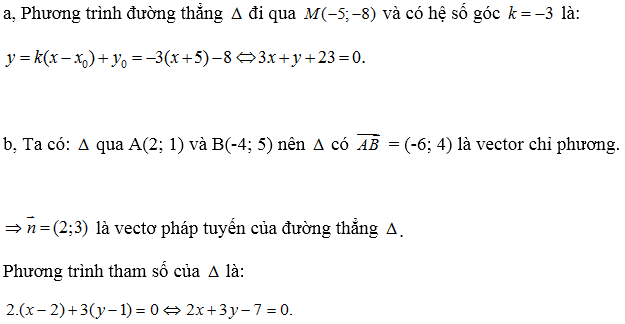Hãy nhập câu hỏi của bạn vào đây, nếu là tài khoản VIP, bạn sẽ được ưu tiên trả lời.

a,\(\Delta_a\) : 3 (x-1) - 2 (y-1) =3x-2y-1=0
b, \(\Delta_b\) : y=-\(\dfrac{1}{2}\)(x-2) =-\(\dfrac{1}{2}\)x =>\(\Delta_b\) : x+2y=0
c,\(\overrightarrow{AB}\)=(-2;-3) =>vtpt \(\overrightarrow{n}\)=(3;-2)
=>\(\Delta_c\): 3 (x-2) - 2(y-0) =0
=>\(\Delta_c\): 3x-2y-6=0
Lời giải
a) \(\Delta_a=3\left(x-1\right)-2\left(y-1\right)=3x-2y+5=0\)
b)\(\Delta_b:y=-\dfrac{1}{2}\left(x-2\right)-1=-\dfrac{1}{2}x\Rightarrow\Delta_b:x+2y=0\)
c) \(\Delta_c:\left(3+0\right)\left(x-2\right)+\left(0-2\right)\left(y-0\right)=3x-2y-6\)

a. phương trình tham số d có dạng : \(\left\{{}\begin{matrix}x=2+3t\\y=1+4t\end{matrix}\right.\)
b. phương trình tham số d có dạng: \(\left\{{}\begin{matrix}x=-2+5t\\y=3+t\end{matrix}\right.\)

a) \(\left\{{}\begin{matrix}x=-5+4t\\y=-2-3t\end{matrix}\right.\)
b) \(\left\{{}\begin{matrix}x=\sqrt{3}+2t\\y=1+3t\end{matrix}\right.\)

Đường tròn tâm O(a,b)
\(\Delta_1\) đi qua \(AB..\Delta_1:\left(x-1\right)-\left(y-2\right)=x-y+1=0\)
\(\Delta_2\) trung trực AB: \(\Delta_2:\left(x-2\right)+\left(y-3\right)=x+y-5=0\)
Tâm (c) phải thuộc \(\Delta_2\) =>O(a,5-a)
Gọi I là điểm tiếp xúc \(\Delta\) và (C) ta có hệ pt
\(\Rightarrow\left\{{}\begin{matrix}OA=OB=\sqrt{\left(a-1\right)^2+\left(5-a-3\right)^2}=R\\OI=\left|3a+\left(5-a\right)-3\right|=\sqrt{10}R\end{matrix}\right.\)
\(\left\{{}\begin{matrix}a^2-2a+1+a^2-4a+4=R^2\\\left(2a+2\right)^2=10R^2\end{matrix}\right.\)
\(\Leftrightarrow\left\{{}\begin{matrix}2a^2-6a+5=R^2\\4a^2+8a+4=10R^2\end{matrix}\right.\)
Lấy [(1) nhân 5] trừ [(2) chia 2]
\(\Leftrightarrow8a^2-32a+23=0\left\{\Delta=16^2-8.23=8.32-8.23=8\left(32-23\right)=2.4.9\right\}\) đề số lẻ thế nhỉ
\(\Rightarrow a=\left[{}\begin{matrix}\dfrac{16-6\sqrt{2}}{8}=2-\dfrac{3\sqrt{2}}{4}\\\dfrac{16+6\sqrt{2}}{8}=2+\dfrac{3\sqrt{2}}{4}\end{matrix}\right.\)
\(\Rightarrow b=\left[{}\begin{matrix}3+\dfrac{3\sqrt{2}}{4}\\3-\dfrac{3\sqrt{2}}{4}\end{matrix}\right.\) \(\Rightarrow R^2=\left[{}\begin{matrix}\dfrac{\left(6-\dfrac{3\sqrt{2}}{2}\right)^2}{10}\\\dfrac{\left(6+\dfrac{3\sqrt{2}}{2}\right)^2}{10}\end{matrix}\right.\)
(C) =(x-2+3sqrt(2)/4)^2 +(y-3-3sqrt(2)/4)^2 =(6-3sqrt(2)/2)^2/10

\(\left\{{}\begin{matrix}t=x-2\\t=\frac{y-3}{2}\end{matrix}\right.\) \(\Rightarrow x-2=\frac{y-3}{2}\Leftrightarrow2x-y-1=0\)
Gọi d là đường thẳng qua A và vuông góc \(\Delta\Rightarrow\) d nhận \(\left(1;2\right)\) là 1 vtpt
Phương trình d: \(1\left(x-3\right)+2y=0\Leftrightarrow x+2y-3=0\)
Gọi C là giao điểm d và \(\Delta\Rightarrow\) tọa độ C thỏa: \(\left\{{}\begin{matrix}2x-y-1=0\\x+2y-3=0\end{matrix}\right.\) \(\Rightarrow C\left(1;1\right)\)
B đối xứng A qua \(\Delta\Leftrightarrow C\) là trung điểm AB
\(\Rightarrow\left\{{}\begin{matrix}x_B=2x_C-x_A=-1\\y_B=2y_C-y_A=2\end{matrix}\right.\) \(\Rightarrow B\left(-1;2\right)\)
\(\Delta'\) đối xứng \(\Delta\) qua A \(\Rightarrow\Delta'//\Delta\) và đi qua B
\(\Rightarrow\Delta'\) nhận \(\left(2;-1\right)\) là 1 vtpt và qua B
Pt \(\Delta'\): \(2\left(x+1\right)-1\left(y-2\right)=0\Leftrightarrow2x-y+4=0\)


